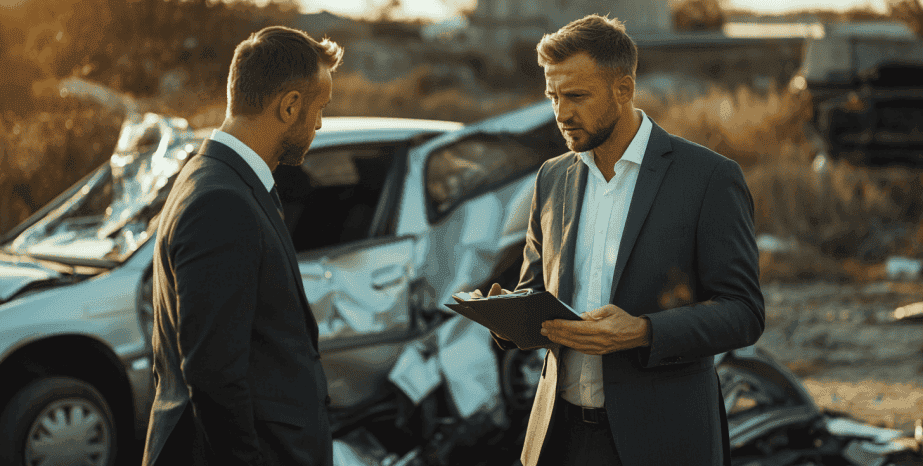8730 Wilshire Boulevard, California 90211
Get Help Now
8730 Wilshire Boulevard, California 90211
Get Help Now

Keep your mouth closed is the first and greatest commandment in these situations. Don’t give a statement to the other driver’s insurance company. If your policy requires you to report the accident, report it but convey no information other than name, rank, and serial number. If police investigators interview you, try to answer every question “yes” or “no.” If you volunteer information, you could compromise your claim for damages. More on that below.
Moreover, if you’re in an accident that’s not your fault, immediately see a doctor, even if you don’t “feel” hurt. Many vehicle collision injuries are impossible to self-diagnose, especially since, in the wake of a crash, the victim is high on adrenaline. Only a doctor who focuses on injury-related conditions can determine how badly you are or are not injured.
Above all, if you’re in a car accident that’s not your fault, call a California Car Accident Attorney. A lawyer evaluates your case and determines your legal options. If the accident wasn’t your fault, these options usually include a negligence action against the tortfeasor (negligent driver). If the other driver was negligent, compensation usually includes money for economic losses, such as medical bills, and noneconomic losses, such as pain and suffering.
Many assume that the other driver’s insurance company immediately writes a check if the accident wasn’t their fault.
In property damage-only claims, that’s often true. An adjuster usually issues a check on the spot. Beware that accepting this check usually constitutes a liability waiver. So, if you have an accident-related medical issue later, such as whiplash, you’re financially responsible for it.
However, most insurance companies have different personal injury departments. These divisions usually fight personal injury claims tooth and nail.
Investigators determine fault based on evidence initially available at the scene, mostly physical evidence, like crash damage patterns, witness statements, and drivers’ statements.
This evidence is often unreliable. Drivers’ statements are a good example. Our eyes aren’t cameras. We see things, and remember things, selectively. Additionally, if you were seriously injured in a crash that wasn’t your fault, most likely, no one took your statement at the scene. So, the ensuing police report only reflects one side of the story.
We should mention medical bills as well. Similar to driver statements, medical bills are sometimes incomplete. Generally, these records don’t include treatment notes that help establish the victim’s pain level. Furthermore, prior medical bills don’t prove the need for future medical treatment, if any.
Due to these weaknesses, a Los Angeles personal injury lawyer typically uses electronic evidence and expert testimony to reinforce the evidence. The other driver may have been at fault, but that doesn’t mean the victim is automatically entitled to compensation.
Electronic evidence usually includes the vehicle’s Event Data Recorder. An EDR is an onboard computer that tracks and records information like:
An experienced personal injury attorney puts these pieces of evidence together like the pieces of a jigsaw puzzle to create a compelling picture for jurors.
A medical expert is usually necessary as well. Typically, this person reviews the existing records and professionally opines about the victim’s pain and the need for future medical services.
We mentioned negligence, which is basically a lack of care, above. If a lack of care, usually an accident that involves aggressive driving or impaired driving, causes injury, compensation is available,
However, we didn’t mention negligence defenses. Comparative fault, in one form or another, may be the most common defense in negligence cases.
Sometimes, contributory negligence applies to the fault/liability question. The other driver could be at fault for the wreck but not liable for damages. For example, the initial evidence might show that Ben’s excessive speed caused the wreck. Subsequent evidence might prove that Jerry’s unsafe lane change substantially caused the wreck.
The comparative fault could also apply to the amount of compensation. Non-use seat belts are a good example. If the victim didn’t buckle up, the victim could be legally responsible for his/her own injuries in California. We’ve seen this issue more in recent years.
Coronavirus lockdowns decreased seat belt compliance. Many drivers on nearly empty roads thought, “Why bother with it?” You need legal representation if you’re in an accident that wasn’t your fault. For a free consultation with an experienced personal injury attorneyin Los Angeles, contact the Law Offices of Eslamboly Hakim. The sooner you reach out to us, the sooner we start working for you.
Credit: Photo by Midjourney
Tag: